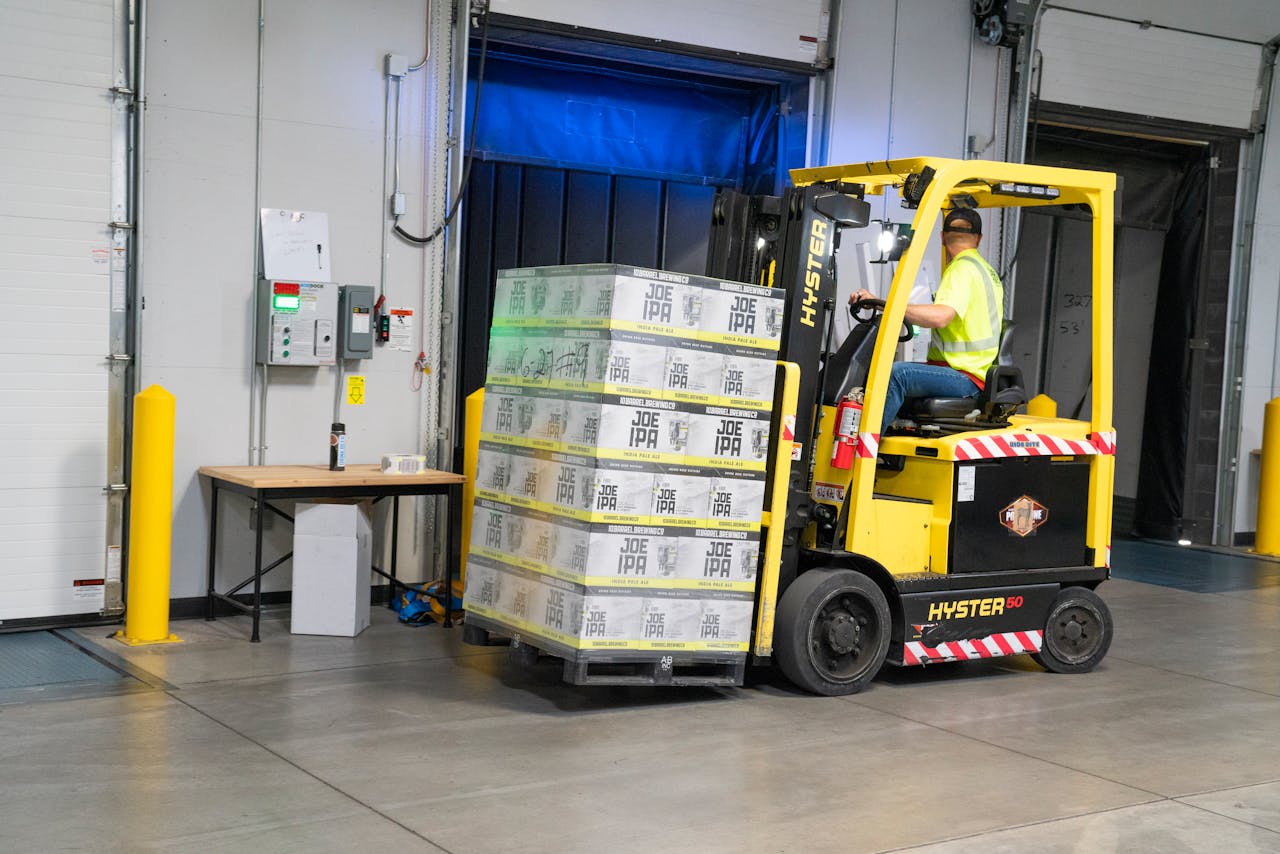Running a smooth, cost-effective storage facility requires careful planning and smart strategies. In this guide, we’ll share proven methods to help businesses streamline their warehouse processes while keeping expenses in check. Whether you’re managing a small storage space or a large distribution centre, these insights can make a real difference.
A well-organised warehouse isn’t just about tidy shelves – it’s the backbone of profitable operations. By improving inventory tracking and adopting modern tools, companies like Dassault Falcon Jet have reduced waste and boosted productivity. Let’s explore practical steps that balance speed, accuracy, and budget considerations.
We’ve analysed success stories from industry leaders such as GF Machining Solutions to identify what works. From layout tweaks to automated systems, small changes often yield big savings. Later sections will break down specific areas like technology integration and staff training, giving you actionable advice tailored to modern challenges.
Key Takeaways
- Strategic organisation directly impacts operational costs
- Advanced inventory systems prevent overstocking and shortages
- Automation tools enhance accuracy while reducing labour hours
- Case studies reveal adaptable solutions for different business sizes
- Continuous improvement maintains long-term efficiency
Ready to transform your space? Our approach combines tried-and-tested techniques with fresh innovations, helping you build a warehouse that works smarter, not harder. Let’s dive in!

Introduction to Warehouse Optimisation
Modern businesses face mounting pressure to deliver goods faster while maintaining tight budgets. Strategic warehouse management bridges this gap by aligning physical spaces with smart workflows. Let’s unpack what this means for your daily operations and long-term success.
What is Warehouse Optimisation?
At its core, it’s a systematic approach to refining storage, movement, and dispatch processes. Key components include:
- Real-time tracking of stock levels
- Intelligent layout designs that minimise travel time
- Data-driven decision-making for resource allocation
Companies using these methods often see order accuracy improvements of 30-40%, directly boosting customer satisfaction.
Key Benefits for Business Efficiency
Upgraded warehouse operations create ripple effects across organisations. Advanced management systems slash picking errors by 65% in some cases, while automated replenishment cuts excess stock by 25%. These changes aren’t just about speed – they reduce labour costs and prevent costly shipping mistakes.
Consider this: businesses with optimised inventory management report 18% higher profit margins than industry averages. That’s the power of having the right products in the right place at the right time.
We’ve seen first-hand how smarter workflows lead to happier customers and healthier bottom lines. It’s not magic – it’s meticulous planning meeting modern technology.
Understanding Operational Costs and Productivity Gains
Efficient management hinges on pinpointing financial drains and productivity leaks within daily routines. By analysing where resources get tied up, teams can make data-backed decisions that boost margins. Let’s explore the metrics that matter and how tracking them transforms storage facilities.
Measuring Cost and Productivity Metrics
Labour costs often top the list of financial burdens, especially when staff retrace steps due to poor layout designs. Equipment maintenance and energy consumption follow closely – neglected machines can inflate budgets by 15% annually. Regular reviews of storage configurations help identify travel time reductions, a proven method used by Bosch Rexroth to cut processing hours by 22%.
Productivity measurement starts with tracking receiving cycle durations and put-away rates. Companies like Unilever found that shaving 90 seconds off each pallet’s processing time added £380,000 in annual savings. Key performance indicators (KPIs) such as order accuracy rates and inventory turnover ratios provide clear benchmarks for warehouse processes – facilities using these metrics report 31% faster error resolution.
Third-party audits frequently reveal hidden inefficiencies. A recent study showed organisations conducting quarterly reviews reduced redundant tasks by 40% within six months. Comparing manual stock checks against barcode systems highlights automation’s value – one retailer slashed counting errors from 8% to 0.3% after implementation, reducing long-term costs.

Embracing Technology in Warehouse Management
Smart tools are revolutionising how facilities handle stock and fulfil orders. Modern storage hubs now rely on digital solutions that connect every process, from receiving goods to shipping products. These innovations aren’t just trendy gadgets – they’re essential for staying competitive in fast-paced markets.
Centralising Data With Smart Systems
A robust warehouse management system (WMS) acts as the brain of modern operations. It collates inventory details across multiple locations into one dashboard, eliminating guesswork. Real-time updates through barcode scanners and IoT sensors help teams:
- Track stock movements down to the minute
- Identify bottlenecks in picking routes
- Automatically reorder items at optimal levels
Businesses exploring the future of warehouse management software report 40% fewer stock discrepancies. One automotive parts supplier slashed order errors by 58% after adopting cloud-based tracking.
Smart Machines Transforming Labour
Automated guided vehicles (AGVs) and autonomous mobile robots (AMRs) now handle repetitive tasks. These technology solutions reduce human fatigue while boosting output:
| Process | Manual Approach | Tech-Driven Solution |
|---|---|---|
| Order Picking | 45 mins per batch | 22 mins with AMRs |
| Stock Checks | 8% error rate | 0.5% with RFID tags |
| Replenishment | 3 staff members | 1 robot + 1 operator |
Leading retailers using robotic sorters process 65% more orders daily. The initial investment pays off quickly – one logistics firm recouped automation costs within 14 months through labour savings.
Combining smart systems with intelligent machines creates a scalable foundation. It’s not about replacing people, but empowering them with better tools. As robotics become more accessible, even mid-sized warehouses can achieve enterprise-level precision.
Optimising Warehouse Layout and Space Utilisation
Smart spatial planning transforms cluttered storage areas into productivity powerhouses. We’ve seen facilities achieve 35% faster processing times simply by rethinking their floor plans. Let’s explore how intelligent design choices create seamless workflows.
Designing an Efficient Layout
A well-planned flow minimises backtracking between receiving docks and dispatch zones. U-shaped configurations work wonders here – workers follow natural pathways instead of crisscrossing aisles. This approach helped a UK electronics distributor reduce staff travel by 42%.
| Process | Traditional Layout | Optimised Layout |
|---|---|---|
| Order Picking | 12-minute average | 7-minute average |
| Stock Replenishment | 3 cross-aisle trips/hour | 0.5 cross-aisle trips/hour |
| Error Rate | 5.8% | 2.1% |
Maximising Storage Capacity
Vertical stacking solutions can triple available space without expanding footprints. One automotive parts supplier achieved this by:
- Installing 11-metre-high racking systems
- Implementing automated storage/retrieval systems (AS/RS)
- Using modular shelving that adapts to seasonal stock changes
Regular layout audits keep facilities aligned with demand shifts. A fashion retailer we worked with conducts quarterly reviews, adjusting 15-20% of their storage zones based on sales trends. This proactive approach maintains space utilisation rates above 85% year-round.
Remember – an efficient warehouse isn’t just about cramming in more pallets. It’s creating a living system that evolves with your business needs while keeping operations flowing smoothly.

How to Optimise Warehouse Operations for Cost Efficiency
Revamping daily processes doesn’t require complex overhauls – it’s about targeted adjustments that compound over time. We’ve helped teams achieve 28% faster order fulfillment through simple workflow tweaks. Let’s explore how structured approaches create lasting change.
Streamlining Daily Routines
Start by mapping staff movements using heat-tracking software. One US electronics distributor discovered workers walked 7 unnecessary miles daily – fixing this saved £18,000 annually in labour costs. Three immediate action points:
- Cluster high-demand items near packing stations
- Implement zone-based picking strategies
- Use colour-coded labels for priority orders
| Process | Traditional Approach | Optimised Method |
|---|---|---|
| Order Picking | Manual search & retrieval | Barcode-guided routes |
| Replenishment | Weekly stock checks | Real-time alerts at 15% stock level |
| Error Rate | 6.2% | 1.8% |
Sustaining Improvements Long-Term
Adopting proven cost-cutting methods creates a ripple effect. A Midwest auto parts supplier reduced mis-picks by 73% after introducing voice-directed picking – their order accuracy now sits at 99.4%. Regular process audits maintain momentum:
- Monthly review of travel patterns
- Quarterly workstation reorganisations
- Annual staff training refreshers
These best practices form a blueprint for continuous growth. Remember – small, consistent changes often outpace grand gestures. One footwear retailer boosted daily shipments by 40% through 12 incremental adjustments over six months. What could your team achieve with focused optimisation?
Enhancing Inventory Management and Control
Clear visibility into stock movements separates thriving businesses from those drowning in excess inventory. Modern tracking solutions give teams laser-focused oversight, preventing both shortages and wasteful surpluses. Let’s explore how smart systems turn guesswork into precision.
Real-Time Inventory Tracking
Live monitoring systems act like GPS for your stock. Sensors and barcode scanners update inventory levels instantly across all channels. This approach helped a US appliance retailer slash misplaced items by 68% within six months.
Key advantages include:
- Minimised manual data entry errors
- Immediate alerts for low stock levels
- Seamless integration with supplier portals
| Method | Stock Accuracy | Response Time |
|---|---|---|
| Manual Counts | 82% | 48 hours |
| Real-Time Systems | 99.1% | 12 minutes |
Accurate Forecasting and Stock Management
Predictive analytics tools analyse sales patterns and seasonal trends. One fashion chain reduced overstocks by 40% while cutting stockouts by 60% using AI-driven forecasts. Regular system audits keep models sharp – we recommend quarterly reviews minimum.
Three rules for success:
- Combine historical data with market trends
- Set automatic reorder points at 20% buffer levels
- Train staff on exception reporting protocols
Proper inventory control isn’t just about numbers – it’s about creating responsive systems. Businesses mastering this balance report 23% lower holding costs and 31% faster restock cycles. Remember, your shelves should work for you, not trap capital in stagnant products.

Streamlining Order Fulfilment and Picking Accuracy
Precision in order processing separates market leaders from competitors scrambling to fix errors. Modern facilities now combine human expertise with smart tech to achieve near-flawless execution. Let’s examine how innovative approaches transform this critical phase.
Advanced Picking Techniques
Voice-directed systems guide workers through optimal routes using real-time audio commands. Put-to-light technology visually signals correct item placement, reducing mis-picks by 72% in one case study. Three game-changing methods:
- Batch picking for clustered orders
- Cross-docking for time-sensitive items
- Robotic cart follow systems
A Chicago medical supplier cut order processing time from 45 to 19 minutes using these strategies. Their order accuracy rate now sits at 99.8%, slashing returns by 63%.
Integration of Order Picking Solutions
Seamless tech integration creates self-correcting workflows. When pick-to-light systems sync with warehouse operations software, stock levels update automatically. This alignment helped a UK retailer achieve:
| Metric | Before Integration | After Integration |
|---|---|---|
| Daily Throughput | 1,200 units | 1,860 units |
| Picking Errors | 4.1% | 0.9% |
| Staff Training Time | 14 hours | 3 hours |
Regular system audits maintain peak performance. Teams using automated replenishment triggers report 38% fewer stockouts during peak seasons. Remember – precise processes don’t just save time, they build customer trust through reliable deliveries.
Implementing Lean Processes and Continuous Improvement
Cutting waste isn’t just about saving money – it’s about building smarter operational habits. Lean methodologies help teams focus on what truly adds value while systematically trimming excess. Let’s explore how this mindset shift creates lasting improvements in storage facilities.
Eliminating Waste for Enhanced Efficiency
Lean warehousing targets seven key waste types, from overproduction to unnecessary motion. A European electronics distributor slashed picking routes by 41% using these principles:
- Mapping staff movements with GPS trackers
- Standardising packing station layouts
- Introducing kanban systems for replenishment
Regular process audits uncover hidden inefficiencies. One retailer found 23% of their stock checks duplicated efforts – fixing this freed up 18 staff hours weekly. Data analytics tools now flag recurring errors, enabling proactive corrections before issues escalate.
Standardised workflows reduce variability in daily tasks. Amazon’s fulfilment centres famously use process templates that decreased training time by 60% while boosting inventory turnover rates. Their secret? Documenting best practices and updating them quarterly.
| Metric | Before Lean | After Lean |
|---|---|---|
| Order Processing Time | 2.3 hours | 1.1 hours |
| Stock Accuracy | 88% | 99.4% |
| Staff Productivity | 72 units/hour | 119 units/hour |
True efficiency comes from treating improvement as a journey, not a destination. Teams that embrace small, weekly tweaks often outpace competitors making occasional big changes. Remember – lean isn’t a one-off project. It’s a culture where every team member spots opportunities to refine processes daily.

Training, Safety, and Cross-Functional Expertise
Investing in people creates the foundation for smooth-running facilities. Our experience shows teams with proper coaching make 38% fewer errors while adapting faster to new systems. Let’s explore how nurturing talent pays dividends across every operation.
Effective Employee Training Strategies
Regular skill-building sessions keep staff sharp and confident. A Midwest retailer reduced picking mistakes by 61% after implementing weekly micro-training:
- 15-minute VR simulations for equipment handling
- Cross-training in receiving, packing, and quality control
- Monthly safety refreshers with scenario role-plays
Augmented reality tools help new hires learn layouts 40% faster. These approaches build versatile teams ready to tackle peak demands without compromising accuracy.
Prioritising Workplace Safety
Protected teams are productive teams. Simple changes like ergonomic workstations cut injury rates by 33% in one study. We recommend:
- Clear visual guides for heavy item handling
- Real-time air quality monitoring
- Emergency protocol drills every quarter
Businesses focusing on labour wellbeing see 27% lower staff turnover. Happy employees directly impact customer satisfaction – their attention to detail ensures orders leave correctly and on time.
Real-World Case Studies and Success Stories
Industry leaders prove daily that smart upgrades transform storage facilities from cost centres into profit engines. Let’s examine how three major businesses achieved remarkable gains through strategic innovation.
Insights from Industry Leaders
Dassault Falcon Jet overhauled their picking processes with autonomous mobile robots. The result? A 57% drop in errors and 22% faster order processing. Their inventory accuracy now sits at 99.3%, slashing stockouts during peak aircraft production cycles.
Innomed Inc. tackled high returns rates by implementing AI-driven quality checks. Real-time barcode scanning reduced shipping mistakes by 62%, while automated sorting systems cut delivery times from 48 to 19 hours. Staff productivity jumped 35% through redesigned workflows.
| Metric | GF Machining (Before) | GF Machining (After) |
|---|---|---|
| Order Accuracy | 87% | 99.7% |
| Storage Costs | £1.2m annually | £780k annually |
| Restock Time | 14 days | 3 days |
These businesses faced common hurdles – outdated management systems and fragmented data streams. By adopting cloud-based warehouse platforms, they created unified visibility across global hubs. GF Machining Solutions reduced excess inventory by 41% through predictive analytics, freeing £2.8m in tied-up capital.
For more proven strategies, explore our curated warehouse automation case studies. These real-world examples demonstrate how adaptable solutions drive measurable growth across industries.
Conclusion
Transforming storage facilities into strategic assets requires blending smart technology with human expertise. We’ve seen businesses achieve 30% faster turnaround by integrating automated systems and lean methodologies. The real magic happens when data-driven tools work alongside staff trained to spot improvement opportunities.
Balancing advanced inventory tracking with streamlined workflows slashes costs in unexpected ways. One retailer reduced energy bills by 18% simply by optimising their picking routes. These changes create ripple effects – happier customers, fewer errors, and resources freed for innovation.
Success lies in treating improvement as an ongoing journey rather than a final destination. Regular process audits and staff upskilling maintain momentum. Let’s keep redefining what’s possible – your facility could be the next case study in operational efficiency.
Ready to start? Review your current operations with fresh eyes today. Small, strategic tweaks often unlock the biggest savings. What step will you take first towards smarter, more sustainable costs management?



